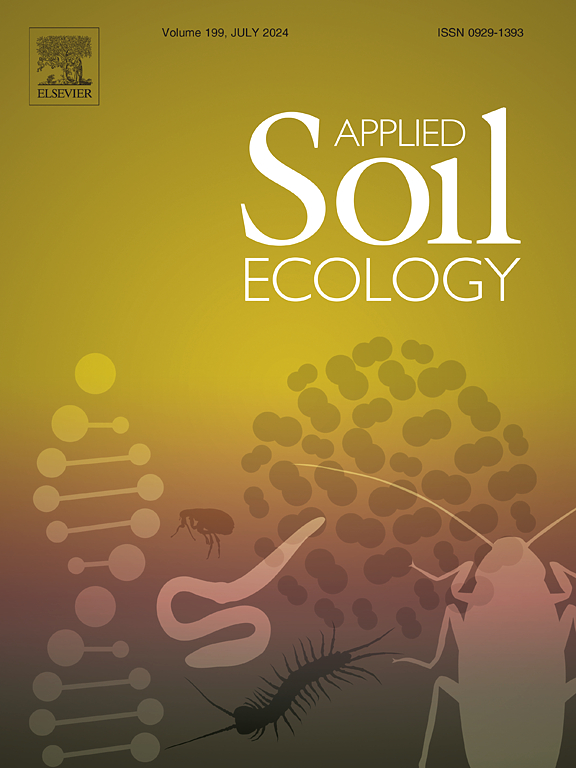植物残体通过增加土壤碳含量调节入侵蚯蚓肠道微生物多样性和碳功能
IF 5
2区 农林科学
Q1 SOIL SCIENCE
引用次数: 0
摘要
泥炭地土壤中存在着丰富的植物残留物,这些植物残留物是否以及如何影响蚯蚓肠道原核生物的组成和结构,以及肠道原核生物与土壤理化性质和土壤原核生物之间的关系尚不清楚。据此,将蚯蚓单独饲喂泥炭土或泥炭土中添加植物残茬饲喂90 d,收集蚯蚓肠道内容物和泥炭土,进行16S rRNA基因测序。结果表明,变形菌门、放线菌门和拟杆菌门在蚯蚓肠道中占主导地位。植物残留物显著降低了氯氟菌的相对丰度,而增加了变形菌的相对丰度。与此同时,植物残体增加了肠道原核生物的丰富度、均匀度和多样性,但随后又降低了丰富度和Shannon多样性。值得注意的是,当引入植物残留物时,土壤溶解有机碳、总碳和与碳相关的胞外酶活性与肠道原核生物群落结构密切相关。蚯蚓肠道中纤维素二糖转运和糖转运相关基因的相对丰度高于土壤中。随着时间的推移,蚯蚓肠道微生物中几丁质和淀粉降解功能基因的丰度与土壤相匹配。结构方程模型表明,植物残体可以通过调节土壤碳含量来改变蚯蚓肠道微生物多样性和碳功能基因。本研究提示在土壤研究中清除植物残留物的做法需要重新考虑。本文章由计算机程序翻译,如有差异,请以英文原文为准。
Plant residues regulate intestinal microbial diversity and carbon function of invasive earthworms by increasing the soil carbon content
There are abundant plant residues in peatland soil, whether and how these plant residues influence the composition and structure of earthworm intestinal prokaryotes, as well as the relationship between intestinal prokaryotes and soil physicochemical properties and soil prokaryotes remains elusive. In this view, earthworms were fed with peat soil alone or peat soil supplemented with plant residues for 90 days, after which their intestinal contents and peat soil were collected for 16S rRNA gene sequencing. The findings revealed that Proteobacteria, Actinobacteria and Bacteroidetes dominated the earthworm gut. Plant residues significantly decreased the relative abundance of Chloroflexi while increasing that of Proteobacteria. Meanwhile, plant residues increased the richness, evenness, and diversity of intestinal prokaryotes while decreasing in richness and Shannon diversity shortly afterward. Of note, when plant residues were introduced, soil dissolved organic carbon, total carbon, and extracellular enzyme activity linked with carbon strongly correlated with intestinal prokaryotic community structure. The relative abundance of genes related to cellobiose transport and sugar transporters in earthworm gut was higher than in soil. Over time, the abundance of chitin and starch degradation functional genes in earthworm gut microbes matched that of soil. The structural equation model revealed that plant residues could change the gut microbial diversity and carbon function genes of earthworms by regulating soil carbon content. This study suggested that the practice of removing plant residues in soil research needs to be reconsidered.
求助全文
通过发布文献求助,成功后即可免费获取论文全文。
去求助
来源期刊

Applied Soil Ecology
农林科学-土壤科学
CiteScore
9.70
自引率
4.20%
发文量
363
审稿时长
5.3 months
期刊介绍:
Applied Soil Ecology addresses the role of soil organisms and their interactions in relation to: sustainability and productivity, nutrient cycling and other soil processes, the maintenance of soil functions, the impact of human activities on soil ecosystems and bio(techno)logical control of soil-inhabiting pests, diseases and weeds.
 求助内容:
求助内容: 应助结果提醒方式:
应助结果提醒方式:


